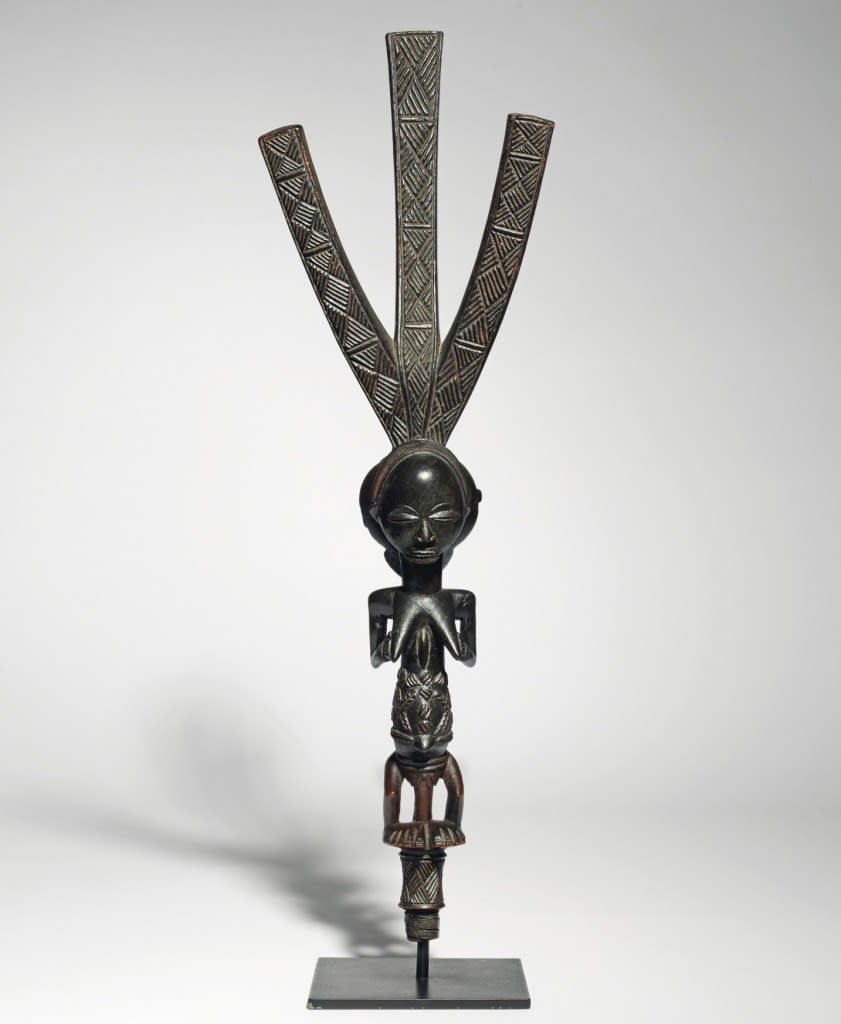
On 9 July 2015, Christie’s London is offering a spectacular Luba bowstand from D.R. Congo attributed to the Warua Master. It will be included in a special auction called “The Exceptional Sale” (info) – bringing a selection of decorative arts, and two important African art objects as well. To have another work by this artist on the market only two months after Sotheby’s NY sold a male statue by this artist (info) is exceptional. That figure was sold for $ 3,6 million (est. $ 3-5 million), the bowstand (by many considered the reference object of this artist and with an even more impressive provenance and publication and exhibition history) is estimated at $ 2,4 – 3,9 million.
The catalogue note (here) was written by Bernard de Grunne, famous for his identifications of master hands and thus well suited for the task. He gives an interesting overview of the various pseudo-names given to this artist through the years and suggests a new name:
This anonymous sculptor has been assigned various conventional names which I list here in chronological order: The Frobenius 1904 Warua Master by Susan Vogel in 1986, the Warua Master by Ezio Bassani in 1990, The Master of the Court of Sopola by François Neyt in 1993 and again the Warua Master by Heinrich Schweizer in 2015. I had suggested in my 2001 catalogue the name Kunda Master, a denomination used subsequently by Petridis in his publication. The Kunda were one of the most important and ancient royal clans of the Eastern Luba, which produced such amazing talent as the Kateba workshop (also know as the Buli Master) and the great Boyo art styles.
The highest concentration of geographical provenance of works by this sculptor are found on both sides of the Luvua River, at the crossroads of Luba, Hemba, Tabwa and Boyo art styles. Of the nine works by this Master, we have the exact geographical origin for one piece, the bowstand from an American Private Collection. It was given to the private collector by Chief Kahulu Ngoy in the village of Kishiale near Piana-Mwanga, the capital of the Batempo Chiefdom, not far from Kiambi. According to Maesen, the Tervuren figure was also collected between 1902 and 1903 not far from Kiambi by Rusmont in the village of Pweto, on the north bank of the Luvua River. The statue from my father’s collection was found in a village near Kiambi according to Dartevelle. Three works of this artist being collected near this river, the Luvua Master could be considered a proper pseudo-name.
In the catalogue note of the male statue sold by Sotheby’s earlier this year, Heinrich Schweizer in his turn wrote:
The name (The Warua Master) was chosen in reference to a male-female janus-figure in the Ethnologisches Museum, Berlin (inv. no. “III.C.19996”) which was collected by the German ethnographer Leo Frobenius in 1904 and labeled by him as “Warua”. While the name has been criticized as too vague and non-descriptive (“Warua” is the Arabic pronunciation of “Baluba”, i.e., “the Luba people”, and was widely used at the time for both the inhabitants as well as the territory west of Lake Tanganyika and north of Lake Moero), none of the other suggested names of convenience convince as they are either just as vague and non-descriptive, or not sufficiently supportable by evidence.
However, as the information gathered by Bernard de Grunne shows, a shift from Warua Master to Luvua Master would more precisely reflect the known geographical distribution of three of his works. But as he himself states, it remains to be seen if this will be accepted in future publications. Note that Christie’s is still using ‘The Warua Master’ for the time being.

This artist carved only nine works: two stools, four bowstands and three statues. In his catalogue note Bernard de Grunne has listed them in a detailed chronological sequence based on their first date of collection and careful archival research:
- Statuette, M.R.A.C., Tervuren inv. N° 26633, collected by Rusmont between 1902 and 1903,7 (above, far right).
- Janus statuette, Berlin Museum für Völkerkunde, inv. N° III C 1996, purchased by Leo Frobenius from Hamburg dealer J.M.G. Umlauff and sold to the Berlin Museum in 1904,8 (above, one from right).
- Bowstand, American Private Collection, New York, collected by Léon Guébels a.k.a. Olivier de Bouveignes between 1913-1918, Willy Mestach, Merton Simpson,9 (above, centre left).
- Stool, Seattle Art Museum, Inv. N° 81.17.876, collected by Lieutenant Roger Castiau, a Belgian pilot based at M’Toa (just north of Kalemie) between April 1st and July 23 1916,10 (Fig. 6 below).
- Stool, University Museum of Archaeology and Anthropology, University of Pennsylvania, Philadelphia, Inv. N° AF5121, purchased from French dealer Charles Vignier in Paris in 1919,11 (Fig. 7 below).
- Bowstand, from the André Lefèvre and René Mendès-France collection, acquired prior to May 1931, (the present lot, above, one from left).
- Bowstand, Frankfurt Museum des Weltkulturen, inv. N° NS.33.8.34, formerly A. Siffert Collection, Gent, acquired prior to 1937,12 (Fig. 5 below).
- Bowstand, Malcolm Collection, collected in situ by Pierre Wustfeld in 1956, (above, centre right).
- Statuette, former Comte B. de Grunne Collection, sold by Pierre Dartevelle, 1975, noted as coming from Kiambi (above, far left).
ps it is interesting to find this bowstand being offered by Christie’s. Only last year, it was exhibited by Entwistle at TEFAF Maastricht (info). Note that the excellent sleuthing of Bernard de Grunne in the current catalogue note shows that this object never belonged to Georges de Miré. The erroneous de Miré provenance was added in the entry of the Sotheby’s catalogue in 1980 and has been repeated ever since. Part of the confusion stems from the fact that de Miré did indeed consign some Oceanic objects from his collection to this 6 May 1931 auction (which included this bowstand). However, Georges de Miré’s African collection was sold six months later on 16 December 1931. At the May sale, the bowstand was consigned by another well-known collector, André Léfèvre.

